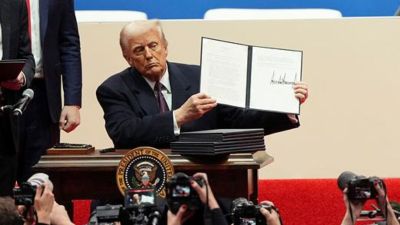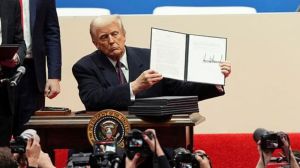Gujarat Hardlook: IIMA’s progression through decades
One of the country’s top-ranking B-School, The Indian Institute of Management Ahmedabad (IIMA), which is into its 63rd year, has seen marked changes over decades, including its operating style, profile of faculty, and students… and some would say even thinking. RITU SHARMA reports Located in Vastrapur — which was once a suburb of Ahmedabad in […]
 The institute has been topping the National Institutional Ranking Framework since 2020 and bagged 42nd rank in QS World University Rankings in 2024 among other accolades. (Express Photo by Bhupendra Rana)
The institute has been topping the National Institutional Ranking Framework since 2020 and bagged 42nd rank in QS World University Rankings in 2024 among other accolades. (Express Photo by Bhupendra Rana) One of the country’s top-ranking B-School, The Indian Institute of Management Ahmedabad (IIMA), which is into its 63rd year, has seen marked changes over decades, including its operating style, profile of faculty, and students… and some would say even thinking. RITU SHARMA reports
Located in Vastrapur — which was once a suburb of Ahmedabad in the 1960s, and is now an upscale locality of the city— the Indian Institute of Management Ahmedabad (IIMA) has grabbed headlines multiple times for a diverse set of reasons in the past couple of years. Be it the discussion to bring down the buildings designed by famous American architect Louis Kahn, which are now dilapidated, or to tweak the logo that takes after the stone lattice work from a city mosque, the enrolment of actor Amitabh Bachchan’s granddaughter Navya Naveli Nanda in its Blended Post Graduate Programme and lately, the alleged suicide of 24-year-old student Akshit Bhukya on the campus — the institute continues to be in the public eye.
The institute has been topping the National Institutional Ranking Framework (NIRF) lists since 2020, and it bagged 42nd rank in QS World University Rankings in 2024 among other accolades. However, winds of change have swept across the institute in the last two decades — the addition of a new campus connected to the old one through a subway, which also acts as a walk-through exhibit sharing details of the people behind the IIMA’s inception. Over the years, the campus that had become a popular hangout spot, especially the Rambhai’s kitli — a literal hole-in-the-wall tea post — has restricted access now. The one day in the year that was designated for the campus tour remains discontinued since Covid-19.
The Indian Express spoke to several faculty members who said that the opening of the new campus in 2005 brought about a huge shift. Then came “a sharp ideological tilt” that began to be seen in the period around 2007. Around this time, finance expert Dr Samir Barua became the first alumnus to occupy the Director’s chair followed by the institute dealing with the global slowdown of 2008. Faculty members say Barua introduced a “directoral control” of working style. It was during his tenure that the IIMA introduced a rigorous faculty performance assessment system. His successor and Harvard Business School professor Ashish Nanda revised this assessment system to a performance credit system with an aim to “incentivise” the faculty towards research and teaching. However, Nanda abruptly quit a year before his term ended in 2017 citing personal reasons. Faculty members recall him as “frequently travelling” during his tenure. A senior faculty member on the condition of anonymity said, “Director Errol D’Souza (2018-2023) would take the faculty along… even though he faced some of the harshest controversies, including the logo change and the proposal to pull down Louis Kahn’s buildings during his tenure”.
While at the cost of academic freedom, the hierarchy has gone up in the recent years — more after 2017 — following the Indian Institutes of Management Act 2017, the faculties at IIMA are of the opinion that the director has a more centralised power or authority to the extent that they are even told which books to use for their courses. There is also a Chief Administrative Officer (CAO), a senior functionary who “provides total administrative support for all the activities of the institute”. He is also the First Appellate Authority (FAA) under the RTI Act, 2005. The CAO participates in business, strategic planning, implementation of policies and oversees day to day operations of the institute. The last few years also saw more women clear the Common Admission Test (CAT), the competitive entrance test to get into the premier B-schools. The presence of women grew from 11 per cent in 2002 to 23 per cent in 2022 in the flagship two-year Post Graduate Programme (PGP). It also saw a change in the profile of the students entering IIMA, with the majority earlier being from engineering background. From barely 5 per cent non-engineers in 2013, the figure reached to 34 per cent in 2022.
Another faculty member, requesting anonymity, said, “In the last one year, there have been stark changes like three courses that were taught by visiting faculties — Prof Harsh Mander, Prof Paranjoy Guha Thakurtha and Sandeep Pandey — were cancelled last year without citing any reason. While Mander was a visiting faculty for the last 12 years, Guha was taking elective courses for the last 19 years and Pandey for seven years.”
“Earlier, we would just have to do paperwork and go ahead with an extracurricular activity. Now, even for small things like a film show along with a talk by the filmmaker is either not allowed or gets no response. So, many faculties have given up on such activities,” a faculty member told The Indian Express.
Following the enforcement of the IIM Act 2017, and after the amendment in 2023, a more authoritarian culture is seen now, as per several people on campus. The IIM Act 2023 amends the 2017 Act to give the President more authority over the institutes. As a Visitor, the President is given the power to audit the functioning of the IIMs and order investigations along with appointment of the director. The board of governors (BoG) should get his approval before appointing a director. The Visitor also nominates one member of the three-member selection committee for the director’s position. The Visitor can terminate a director’s services and also nominate the chairperson. While some academicians believe that the amendments increase accountability, others, however, say these allow the government to use the IIMs for their agenda. Sources say, earlier students would be given a budget for different activities. “But the things accentuated during The Red Bricks Summit (TRBS),” a final year student told The Indian Express. Bhukya, a final-year student from Telangana who was the TRBS coordinator, was found dead in his room a day before the event on September 26. The student’s father Hemanth attributed the death to pressure from a staff member. Following the incident, the Students’ Affair Committee (SAC) general secretary Atman Soni wrote to director Prof Bharat Bhasker, the board of governors’ alumni and faculty alleging that an administrative officer was responsible for the death while demanding a panel to probe the matter. Director Bhasker later met with the SAC members and the institute also formed an Assessment, Review and Reform (ARR) committee to review the major student events involving external and administrative interfaces. The IIMA called off the TRBS after Bhukya’s death, but the same day, the institute hosted a Chintan Shivir presided over by CM Bhupendra Patel for his officials, wrote the students in their letter to the director.
Growing disconnect
The faculty members and students while speaking to The Indian Express shared that the interaction between them has now become “minimal” along with reduction of common social spaces on campus. The new campus has single-occupancy hostel rooms with no shared facilities while the old hostels had common bathrooms, said one of them. Meenakshi Nath, a 1987-batch IIMA alumna who did a survey in 2022 covering 105 students of both old and new campus says, “85 per cent students preferred the old campus”. “…the organic interaction that would happen on the old campus is no longer there. The new campus is great for privacy but offers nothing to enhance interaction. In the age of social media, you have to focus on physical interactions,” she added.
Prof G Raghuram (69), an alumnus and former faculty of IIMA (from 1985-2017) who joined in 2017 as the IIM Bangalore director believes that interactions have also changed because of increase in number of students on the campus as well as faculty. All institutes need to step up in how they deal with mental health issues, he said. “The leadership should reach out to the family on indications of any proclivity to personality issues (in a student) along with an increase in counselling/psychotherapy bandwidth of the institute,” he said.
“There should be active counselling rather than passive. The number of counsellors should increase, for instance for 500 students we need at least 10 counsellors. These issues are seen more in the first and second semesters when the students are new to the performance pressure. Parents should be encouraged to share any prior instances of personality issues. The institution has a responsibility over the years when the student is in their charge,” he added.
Meanwhile, a student said there was a “strong disconnect between faculty, administration and students now”. According to the student, “The PGP office has now become like a central control… students are even scared of talking directly to the faculty now”. Students from over 25 clubs and activity groups feel that approvals have become rare and selective in nature. “The IIMA administration recently declined a music event request of a Carnatic musician. In another instance, students were charged for an event inviting an author for a talk,” one of the students associated with the event told The Indian Express. A senior faculty member shared how earlier the faculty and academic council was active and is now redundant. “The faculty council has now turned into a non-decision-making body. In the logo change case, it was approved by the BoG and then brought to the notice of the faculty. Even in the case of the old campus, the faculty council had no say,” another faculty member stated.
Louis Kahn buildings
The old campus academic block has not been used since July 2022. Now, the faculty is spread across old and new campuses, in terms of accommodation and offices. From about a little over 100 regular faculty members, 95 per cent are staying on the old campus while others are on the new one. Talking about the “emotional connect”, Ashok Shah, a former administrative official at IIMA, said: “We did not know the value of Louis Kahn designs nor had those eyes to appreciate them but there is certainly something about them.”
“I realised it while working with different groups of people who visited the campus from across the world… just because it is one of Louis Kahn’s buildings. There were scheduled group tours for visiting the building,” Shah said. “There were no budget constraints but then look at the designs… the smaller personal spaces and the larger public spaces. Though there were smaller rooms for faculty and students, the library building is the tallest. He believed students should interact with people as they are in the management field.” Till 2022, all the faculty offices were in the Louis Kahn Plaza; now they are spread across Kasturbhai Lalbhai Management Development Centre (KLMDC), New Academic Block and the Forum Tower.
Restoration of heritage campus
In 2013, IIMA selected Somaya and Kalappa Consultants to carry out the restoration work on the old campus. The first buildings to be restored were Vikram Sarabhai Library and Dorm 15. Library restoration work was completed in 2018, after over two years. The library building situated at the apex of the Louis Kahn Plaza was constructed between 1968-75. The library consists of ground plus four floors and is divided into two wings by a central circulation area which has two staircases (with a common landing) on either side. The restoration project also won the Award of Distinction of the UNESCO Asia-Pacific Award for Cultural Heritage Conservation in 2019. Under the second phase, the restoration work on Dorm 15 started in 2016 and completed within a year. The dormitory D15, a boys’ dorm, was among the first set of dormitories constructed on campus around 1964-69.
Changing regulations
The IIM Act 2023 mandates the director be appointed by the Board of Governors, based on the recommendations of a search-cum-selection committee. The board has to obtain prior approval of the Visitor before the appointment, the procedure for which is prescribed by the Centre. The Search Committee comprises the Board Chairperson and three members. The Act reduces these three members to two, and adds another member to be nominated by the Visitor. Going by the IIM Act 2017, the director should be the chief executive officer of the institute and be responsible for implementation of the Board’s decisions. The director should be appointed from names recommended by search panel constituted by the Board, consisting of the board chairperson. The Board Chairperson should also be the Chairperson of the search- cum-selection committee and the three members in the panel should be eminent administrators, industrialists or educationists. If the board is not satisfied with the recommendations, it may ask for fresh recommendations.
The Indian Express tried to contact Prof Bharat Bhasker, who took over as IIMA director on March 1, 2023, but got no response. Email to BoG chairman Pankaj Patel for remarks on the matter also did not elicit a reply.







